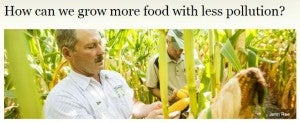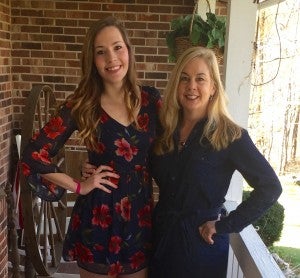Producers and environmental groups haven’t always been the best of friends. That’s why, when I got an internship this summer with Environmental Defense Fund (EDF), my mom was more than a little uneasy.
My mom, Kay Johnson Smith, is president and CEO of the Animal Agriculture Alliance, a non-profit group that supports producers and promotes better consumer understanding of modern animal agriculture.
After learning more about EDF, my mom eventually came around to the idea of my working for a conservation organization. That’s because I shared with her EDF’s mission and explained that the organization works with producers to meet the growing demands for food in ways that also improve the environment. I’m happy to say that she now is pleased to see me working to bridge the gap of skepticism between producers and environmental groups.
As part of EDF’s effort to work with diverse partners and to share their voices, I asked my mom to share what motivates her work and her vision on the role of sustainability in U.S. agriculture.
What led you to the ag industry and why is this work so important to you?
Growing up, I had very little interest in agriculture – my dad called me “a city girl growing up in the country.” But through my professional growth, I’ve discovered my passion for agriculture because of the people – the farmers and ranchers – who are just like my family. I’ve come to realize that they do what they do because they, like my family, love their land and their animals.
But with so many outside pressures from groups that don’t understand farming and the generational gap between the vast majority of the public and farmers, today, more than ever, farmers need someone to champion their voice. For over 25 years, I’ve worked to help do that, and I love knowing that our work at the Alliance makes a difference on their behalf.
What would you say is the biggest issue facing producers today?
Pressure and misinformation from groups that do not support modern agricultural practices, or oppose raising animals for food altogether.
This is a huge challenge. It’s especially problematic given that food production will need to increase to feed our growing population.
You talk about bridging the communication gap between farm and fork. How do you do this?
We often talk about radical transparency, and the Alliance highlights our members’ initiatives to do that. At our most recent annual Stakeholders Summit, for example, we featured two farms that are opening up their operations to the public.
Fair Oaks Farm in Indiana is a large working farm with both a large modern dairy and a hog operation. It is open to the public and showcases modern animal housing, innovative processes and technologies that help produce food efficiently and in ways that conserve natural resources and protect the environment. The thousands of visitors who tour each year get to see every aspect of the farm’s day-to-day operations and ask questions about anything.
Cooper Farms in Ohio, which has turkey, hog and egg laying hen farms, has added viewing windows in many of its newer barns to allow their customers to see inside. They are very proud of their operations – as are most farmers – so they found a way to showcase what they do without impacting their biosecurity protocols.
Where do you see the role of sustainability in the future of agriculture in America?

Learn more about EDF’s commitment to achieving profitable, sustainable agriculture at edf.org. Also learn how EDF is working with Smithfield Foods, the world’s largest pork producer, to cut emissions.
Agriculture is essential to life. Therefore, it must be sustainable to ensure future generations of farmers and to protect domestic food production.
To me, three key factors determine sustainability:
- We must be efficient and embrace innovative ideas and technologies that allow us to produce enough food for a growing population.
- We must conserve and protect natural resources.
- We must ensure the profitability of farmers who are producing high-quality, safe and affordable food.


4 Comments
Nicely done. I would add that the United States government has made the food supply chain a national security infrastructure component. It is vital to the security of the country to ensure that the food grown, raised, processed slaughtered,and pakaged for consumtion is done securely, safely and kept it from being deliberately adulterated or contaminated. This is not small or inexspensive task. It requires cooperation from each level within the food supply chain. Small errors cause significant problems. Peoples health and lives are at risk. An example of such an error is where Blue Bell ice cream was contaminated with a pathogen (listeria) and that resulted in three deaths and several (20+) people sick. The best evidence so far is it occured due to a failure to ahere to strigngent production controls and sanitary protocols. Which brings me back to making a point that individuals that enter the food supply chain unlawfully with the the intent to document their motives or beliefs put the food supply chain at risk. An as I noted above even an inadvertent error can cause problems that risk lives of the people that rely on a safe and secure food supply.
Good stuff (: I’ll definitely be checking in, keep the posts coming
Great job, Peyton!! Loved your interview! Well done!! :-) E
Way to go, Peyton!!